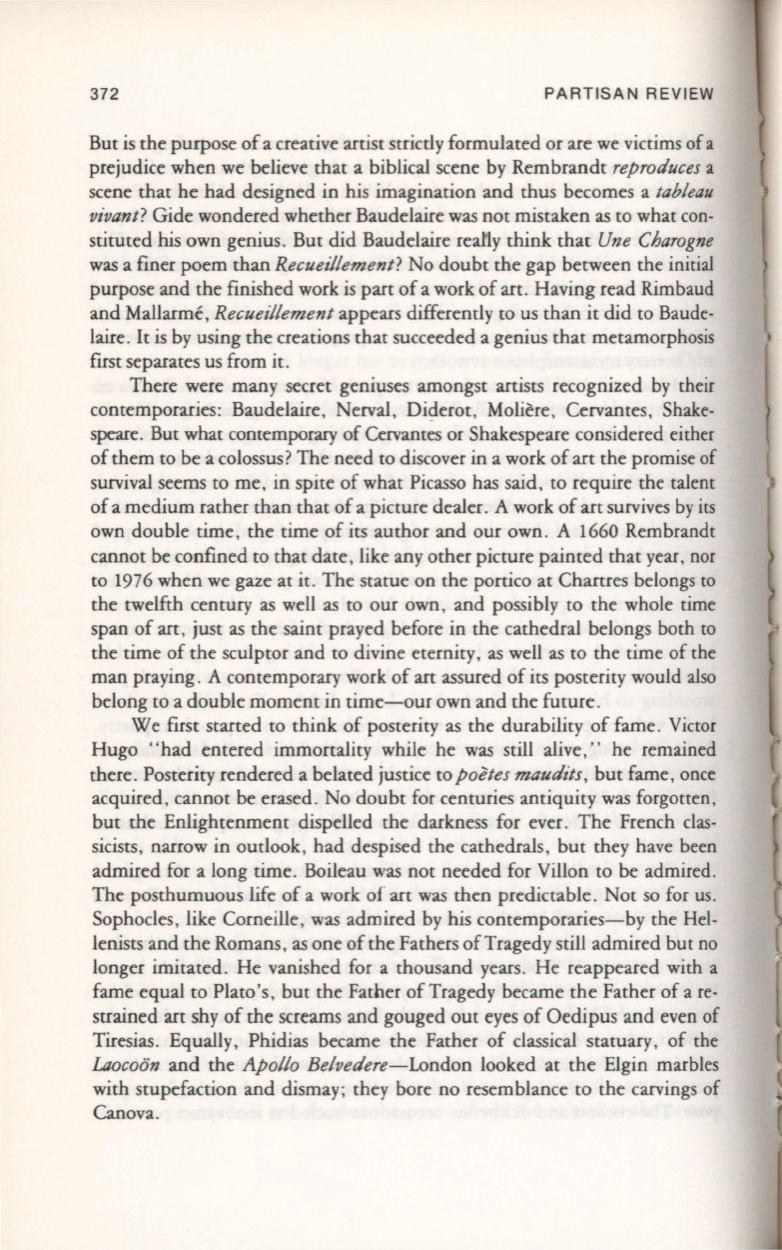
372
PARTISAN REVIEW
But is the purpose of a creative artist strictly formulated or are we victims of a
prejudice when we believe that a biblical scene by Rembrandt
reproduces
a
scene that he had designed in his imagination and thus becomes a
tableau
vivant?
Gide wondered whether Baudelaire was not mistaken as to what con–
stituted his own genius . But did Baudelaire rearly think that
Une Charogne
was a finer poem than
RecuetJlement?
No doubt the gap between the initial
purpose and the finished work is part of a work of art. Having read Rimbaud
and Mallarme,
Recuetllement
appears differently to us than it did to Baude–
laire .
It
is by using the creations that succeeded a genius that metamorphosis
first separates us from it.
There were many secret geniuses amongst artists recognized by their
contemporaries: Baudelaire, Nerval,
Di~erot,
Moliere, Cervantes, Shake–
speare. But what contemporary of Cervantes or Shakespeare considered either
of them to be a colossus? The need to discover in a work of art the promise of
survival seems to me, in spite of what Picasso has said, to require the talent
of a medium rather than that of a picture dealer. A work of art survives by its
own double time , the time of its author and our own . A 1660 Rembrandt
cannot be confined to that date, like any other picture painted that year, nor
to 1976 when we gaze at it. The statue on the portico at Chartres belongs to
the twelfth century as well as to our own, and possibly to the whole time
span of art, just as the saint prayed before in the cathedral belongs both to
the time of the sculptor and to divine eternity, as well as to the time of the
man praying. A contemporary work of art assured of its posterity would also
belong to a double moment in time-our own and the future .
We first started to think of posterity as the durability of fame . Victor
Hugo "had entered immortality while he was still alive," he remained
there. Posterity rendered a belated justice to
poetes maudits
,
but fame, once
acquired, cannot be erased. No doubt for centuries antiquity was forgotten,
but the Enlightenment dispelled the darkness for ever . The French clas–
sicists, narrow in outlook, had despised the cathedrals, but they have been
admired for a long time . Boileau was not needed for Villon to be admired .
The posthumuous life of a work of art was then predictable . Not so for us.
Sophocles , like Corneille, was admired by his contemporaries-by the Hel–
lenists and the Romans, as one of the Fathers of Tragedy still admired but no
longer imitated . He vanished for a thousand years. He reappeared with a
fame equal to Plato's, but the Father of Tragedy became the Father of a re–
strained art shy of the screams and gouged out eyes of Oedipus and even of
Tiresias . Equally, Phidias became the Father of classical statuary, of the
Laocoon
and the
Apollo Belvedere-London
looked at the Elgin marbles
with stupefaction and dismay; they bore no resemblance
to
the carvings of
Canova .


